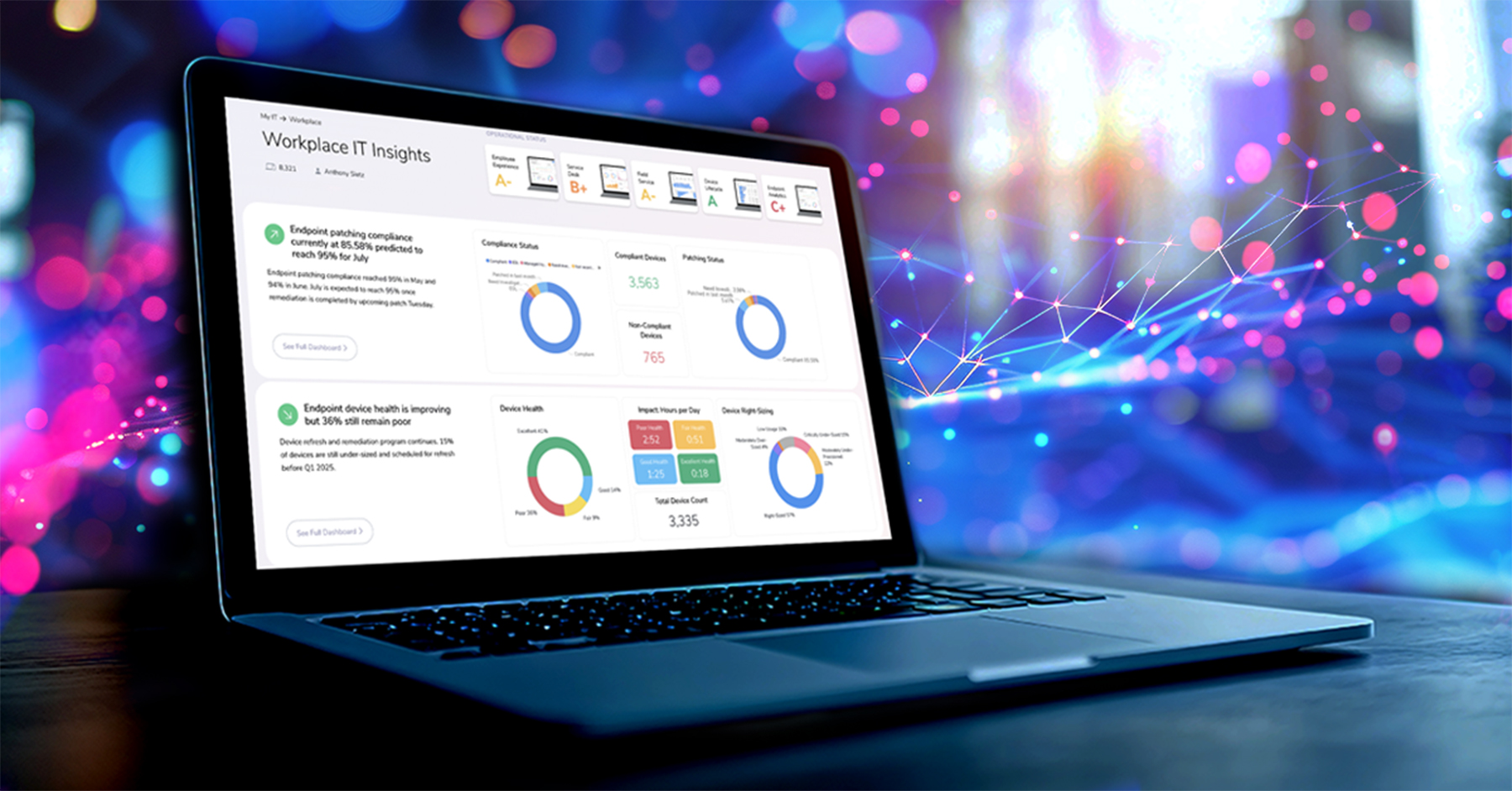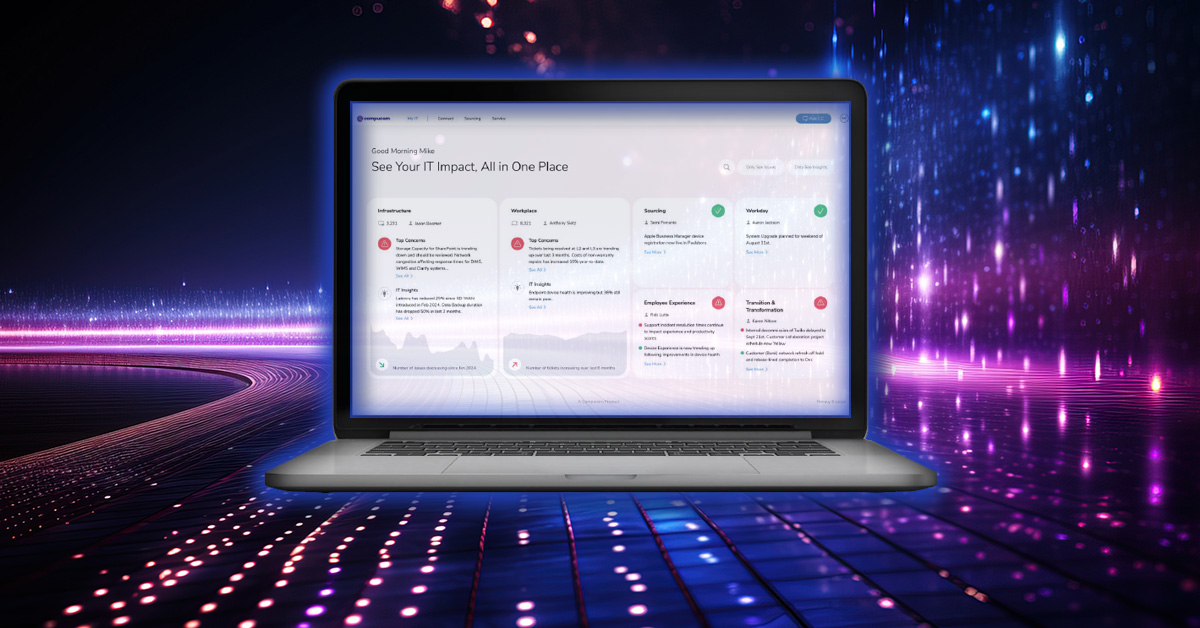- Managed Infrastructure and Cloud Services
- Full Lifecycle Observability


Emma Mak • Staff Writer
Remember when one terabyte seemed massive? Today, it’s not uncommon for an enterprise to deal with petabyte-scale data. To give this context, when the original iPod (5GB) was released in 2001, it was advertised as putting “1,000 songs in your pocket.” One Petabyte holds nearly 210 million songs, more than double the entire current Apple Music song catalog.
Not only is this deluge of enterprise data the key to understanding customer preferences and behaviors and multiple other business metrics, but, looking internally, it’s the basis for improving operational efficiency and reducing costs for IT operations.
The Untapped Potential of Unused IT Infrastructure Data
Despite an overwhelming abundance of data, many enterprises fail to capitalize on its full potential. The valuable insights into the cause of inefficiencies, potential system failures, and poor digital experience are lost because IT teams don’t have the tools to make sense of the large-scale data generation in real time.
Reaping the benefits of infrastructure data is akin to panning for gold in an overflowing river. Just as prospectors sifted through tons of sediment to find precious nuggets, IT professionals must filter through vast amounts of data to extract meaningful information. So how can the modern enterprise best do this to realize the true potential of its IT infrastructure?
Understanding the Data Explosion in Modern IT
Today’s IT environments comprise a multitude of devices, applications, and systems that generate an incessant flow of data. The nature of the data varies, including structured data stored in relational databases or spreadsheets, semi-structured data from NoSQL databases, XML, or JSON files, and unstructured data such as sensor data, log files, and time-series data.
Think of the vastness and complexity of daily data from your company’s alerts, traces, logs, and user interactions. For IT teams, this data explosion can quickly become overwhelming. They can struggle to understand the overall health of systems and where they should focus their troubleshooting and optimization efforts.
The Challenge of Data Silos: Fragmentation and Lack of Integration
A significant obstacle to leveraging enterprise data is the prevalence of data silos, fragmenting information across different systems and departments. Isolated pockets of information hinder collaboration and comprehensive analysis and prevent a holistic view of the organization’s data landscape. Integrating data from disparate sources to derive actionable insights often requires significant effort and resources, delaying decision-making processes.
Strategies for Unlocking Data’s Potential
A frequent analogy for data produced by the modern enterprise is to call it the new oil. It’s apt in that data can be precious, powerful, and pivotal to driving business success. But, as the 2020s have introduced new complexities and risks associated with data management, and enterprise data is expanding at a compound annual growth rate (CAGR) of 28%, a comparison to radioactive substances might be closer to the mark.
“Much like radioactive substances, data holds immense potential for creating positive change and innovation. However, it also carries inherent risks that must be carefully managed.”
InsideAINews.com
To overcome these challenges and harness the true power of their data, enterprises must adopt a strategic approach. Here are some actionable strategies:
1. Implement Data Governance
Effective data governance policies ensure data is accurate, consistent, and secure. Establishing clear protocols for data collection, storage, and usage can mitigate risks and enhance trust in the data.
2. Invest in Scalable Infrastructure
Scalable infrastructure solutions, such as cloud-based platforms, offer the flexibility needed to manage growing data volumes. These solutions can adapt to changing demands, ensuring that enterprises can handle data efficiently and cost-effectively.
3. Leverage Advanced Analytics
Advanced analytics tools powered by Artificial Intelligence (AI) and Machine Learning (ML) can sift through vast amounts of data to identify patterns, trends, and anomalies. These insights can inform proactive decision-making and predictive maintenance.
Compucom’s Full Lifecycle Observability
“Observability is the ability to understand what is happening inside a system based on the external data released by that system. Observability requires that actionable data from multiple sources is appropriately connected, optimized and enhanced for context.”
Gartner
At Compucom, we know that providing observability as part of our services delivers true value for our customers. The Full Lifecycle Observability (FLO) framework underpins all our services and provides real-time visibility to all IT and business leaders through a variety of metrics that matter most to their business. It includes a technology stack that provides AI-generated insights and recommendations visualized in a dashboard. By integrating advanced tools with your IT infrastructure and workplace technologies, we can provide a consolidated view of all the data in real time and transform the deluge of data into actionable insights.
The FLO framework combines AI for IT Operations (AIOps) and Digital Experience Management to offer three overall benefits for companies by helping them:
- Make data-driven decisions on IT strategy, innovation, and operations.
- Enhance system monitoring and analysis capabilities.
- Improve infrastructure troubleshooting and optimization capabilities.
Through insights and recommendations from FLO and our experts, we empower IT leaders to make proactive, data-driven decisions that lead to positive business outcomes, such as improved accuracy of asset intelligence, a more compliant environment, an improved digital user experience, and more. With FLO, IT leaders can harness the power of data to reduce IT complexity and enable proactive management of their IT environment.
For IT leaders, the path to data mastery may be complex, but the rewards are well worth the effort. Partner with us and adopt a strategic and integrated approach to data management, ensuring that terabytes of data don’t go to waste but contribute to business success.
RecenT

9 Ways Strategic IT Staffing Empowers Organizations

Case Studies: Asset Intelligence and Endpoint Compliance Made Easy

AI and the Enterprise: The Future of IT Management

Exploring the Opportunities and Obstacles of AI in the Enterprise

One Dashboard to Rule Them All: Strategic IT Excellence with Full Lifecycle Observability

Transforming IT Operations with Full Lifecycle Observability: How Compucom’s FLO Framework Redefines Data-Driven Efficiency
TOPICS
Unlocking Data’s Potential: 3 Strategies That Drive Results
- Managed Infrastructure and Cloud Services
- Full Lifecycle Observability

Emma Mak • Staff Writer
Remember when one terabyte seemed massive? Today, it’s not uncommon for an enterprise to deal with petabyte-scale data. To give this context, when the original iPod (5GB) was released in 2001, it was advertised as putting “1,000 songs in your pocket.” One Petabyte holds nearly 210 million songs, more than double the entire current Apple Music song catalog.
Not only is this deluge of enterprise data the key to understanding customer preferences and behaviors and multiple other business metrics, but, looking internally, it’s the basis for improving operational efficiency and reducing costs for IT operations.
The Untapped Potential of Unused IT Infrastructure Data
Despite an overwhelming abundance of data, many enterprises fail to capitalize on its full potential. The valuable insights into the cause of inefficiencies, potential system failures, and poor digital experience are lost because IT teams don’t have the tools to make sense of the large-scale data generation in real time.
Reaping the benefits of infrastructure data is akin to panning for gold in an overflowing river. Just as prospectors sifted through tons of sediment to find precious nuggets, IT professionals must filter through vast amounts of data to extract meaningful information. So how can the modern enterprise best do this to realize the true potential of its IT infrastructure?
Understanding the Data Explosion in Modern IT
Today’s IT environments comprise a multitude of devices, applications, and systems that generate an incessant flow of data. The nature of the data varies, including structured data stored in relational databases or spreadsheets, semi-structured data from NoSQL databases, XML, or JSON files, and unstructured data such as sensor data, log files, and time-series data.
Think of the vastness and complexity of daily data from your company’s alerts, traces, logs, and user interactions. For IT teams, this data explosion can quickly become overwhelming. They can struggle to understand the overall health of systems and where they should focus their troubleshooting and optimization efforts.
The Challenge of Data Silos: Fragmentation and Lack of Integration
A significant obstacle to leveraging enterprise data is the prevalence of data silos, fragmenting information across different systems and departments. Isolated pockets of information hinder collaboration and comprehensive analysis and prevent a holistic view of the organization’s data landscape. Integrating data from disparate sources to derive actionable insights often requires significant effort and resources, delaying decision-making processes.
Strategies for Unlocking Data’s Potential
A frequent analogy for data produced by the modern enterprise is to call it the new oil. It’s apt in that data can be precious, powerful, and pivotal to driving business success. But, as the 2020s have introduced new complexities and risks associated with data management, and enterprise data is expanding at a compound annual growth rate (CAGR) of 28%, a comparison to radioactive substances might be closer to the mark.
“Much like radioactive substances, data holds immense potential for creating positive change and innovation. However, it also carries inherent risks that must be carefully managed.”
InsideAINews.com
To overcome these challenges and harness the true power of their data, enterprises must adopt a strategic approach. Here are some actionable strategies:
1. Implement Data Governance
Effective data governance policies ensure data is accurate, consistent, and secure. Establishing clear protocols for data collection, storage, and usage can mitigate risks and enhance trust in the data.
2. Invest in Scalable Infrastructure
Scalable infrastructure solutions, such as cloud-based platforms, offer the flexibility needed to manage growing data volumes. These solutions can adapt to changing demands, ensuring that enterprises can handle data efficiently and cost-effectively.
3. Leverage Advanced Analytics
Advanced analytics tools powered by Artificial Intelligence (AI) and Machine Learning (ML) can sift through vast amounts of data to identify patterns, trends, and anomalies. These insights can inform proactive decision-making and predictive maintenance.
Compucom’s Full Lifecycle Observability
“Observability is the ability to understand what is happening inside a system based on the external data released by that system. Observability requires that actionable data from multiple sources is appropriately connected, optimized and enhanced for context.”
Gartner
At Compucom, we know that providing observability as part of our services delivers true value for our customers. The Full Lifecycle Observability (FLO) framework underpins all our services and provides real-time visibility to all IT and business leaders through a variety of metrics that matter most to their business. It includes a technology stack that provides AI-generated insights and recommendations visualized in a dashboard. By integrating advanced tools with your IT infrastructure and workplace technologies, we can provide a consolidated view of all the data in real time and transform the deluge of data into actionable insights.
The FLO framework combines AI for IT Operations (AIOps) and Digital Experience Management to offer three overall benefits for companies by helping them:
- Make data-driven decisions on IT strategy, innovation, and operations.
- Enhance system monitoring and analysis capabilities.
- Improve infrastructure troubleshooting and optimization capabilities.
Through insights and recommendations from FLO and our experts, we empower IT leaders to make proactive, data-driven decisions that lead to positive business outcomes, such as improved accuracy of asset intelligence, a more compliant environment, an improved digital user experience, and more. With FLO, IT leaders can harness the power of data to reduce IT complexity and enable proactive management of their IT environment.
For IT leaders, the path to data mastery may be complex, but the rewards are well worth the effort. Partner with us and adopt a strategic and integrated approach to data management, ensuring that terabytes of data don’t go to waste but contribute to business success.
Recent Blogs

9 Ways Strategic IT Staffing Empowers Organizations

Case Studies: Asset Intelligence and Endpoint Compliance Made Easy

AI and the Enterprise: The Future of IT Management

Exploring the Opportunities and Obstacles of AI in the Enterprise

One Dashboard to Rule Them All: Strategic IT Excellence with Full Lifecycle Observability




